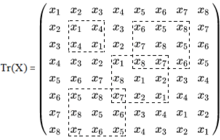Transpositions matrix (Tr matrix) is square matrix, , , which elements are obtained from the elements of given n-dimensional vector as follows: , where denotes operation "bitwise Exclusive or" (XOR). The rows and columns of Transpositions matrix consists permutation of elements of vector X, as there are n/2 transpositions between every two rows or columns of the matrix
Example
The figure below shows Transpositions matrix of order 8, created from arbitrary vector
Properties
- matrix is symmetric matrix.
- matrix is persymmetric matrix, i.e. it is symmetric with respect to the northeast-to-southwest diagonal too.
- Every one row and column of matrix consists all n elements of given vector without repetition.
- Every two rows matrix consists fours of elements with the same values of the diagonal elements. In example if and are two arbitrary selected elements from the same column q of matrix, then, matrix consists one fours of elements , for which are satisfied the equations and . This property, named “Tr-property” is specific to matrices.

The figure on the right shows some fours of elements in matrix.
Transpositions matrix with mutually orthogonal rows (Trs matrix)
The property of fours of matrices gives the possibility to create matrix with mutually orthogonal rows and columns ( matrix ) by changing the sign to an odd number of elements in every one of fours , . In is offered algorithm for creating matrix using Hadamard product, (denoted by ) of Tr matrix and n-dimensional Hadamard matrix whose rows (except the first one) are rearranged relative to the rows of Sylvester-Hadamard matrix in order , for which the rows of the resulting Trs matrix are mutually orthogonal.
where:
- "" denotes operation Hadamard product
- is n-dimensional Identity matrix.
- is n-dimensional Hadamard matrix, which rows are interchanged against the Sylvester-Hadamard matrix in given order for which the rows of the resulting matrix are mutually orthogonal.
- is the vector from which the elements of matrix are derived.
Orderings R of Hadamard matrix’s rows were obtained experimentally for matrices of sizes 2, 4 and 8. It is important to note, that the ordering R of Hadamard matrix’s rows (against the Sylvester-Hadamard matrix) does not depend on the vector . Has been proven that, if is unit vector (i.e. ), then matrix (obtained as it was described above) is matrix of reflection.
Example of obtaining Trs matrix
Transpositions matrix with mutually orthogonal rows ( matrix) of order 4 for vector is obtained as:
where is matrix, obtained from vector , and "" denotes operation Hadamard product and is Hadamard matrix, which rows are interchanged in given order for which the rows of the resulting matrix are mutually orthogonal. As can be seen from the figure above, the first row of the resulting matrix contains the elements of the vector without transpositions and sign change. Taking into consideration that the rows of the matrix are mutually orthogonal, we get
which means that the matrix rotates the vector , from which it is derived, in the direction of the coordinate axis
In are given as examples code of a Matlab functions that creates and matrices for vector of size n = 2, 4, or, 8. Stay open question is it possible to create matrices of size, greater than 8.
See also
References
- Harville, D. A. (1997). Matrix Algebra from Statistician’s Perspective. Softcover.
- Horn, Roger A.; Johnson, Charles R. (2013), Matrix analysis (2nd ed.), Cambridge University Press, ISBN 978-0-521-54823-6
- Mirsky, Leonid (1990), An Introduction to Linear Algebra, Courier Dover Publications, ISBN 978-0-486-66434-7
- Baumert, L. D.; Hall, Marshall (1965). "Hadamard matrices of the Williamson type". Math. Comp. 19 (91): 442–447. doi:10.1090/S0025-5718-1965-0179093-2. MR 0179093.
- Zhelezov, O. I. (2021). Determination of a Special Case of Symmetric Matrices and Their Applications. Current Topics on Mathematics and Computer Science Vol. 6, 29–45. ISBN 978-93-91473-89-1.

 ,
,  , which elements are obtained from the elements of given n-dimensional vector
, which elements are obtained from the elements of given n-dimensional vector  as follows:
as follows:  , where
, where  denotes operation "
denotes operation " of order 8, created from arbitrary vector
of order 8, created from arbitrary vector 

 matrix is
matrix is  without repetition.
without repetition. fours of elements with the same values of the diagonal elements. In example if
fours of elements with the same values of the diagonal elements. In example if  and
and  are two arbitrary selected elements from the same column q of
are two arbitrary selected elements from the same column q of  , for which are satisfied the equations
, for which are satisfied the equations  and
and  . This property, named “Tr-property” is specific to
. This property, named “Tr-property” is specific to  matrix ) by changing the sign to an odd number of elements in every one of fours
matrix ) by changing the sign to an odd number of elements in every one of fours  . In is offered algorithm for creating
. In is offered algorithm for creating  ) of Tr matrix and n-dimensional
) of Tr matrix and n-dimensional  , for which the rows of the resulting Trs matrix are mutually orthogonal.
, for which the rows of the resulting Trs matrix are mutually orthogonal.


 is n-dimensional Identity matrix.
is n-dimensional Identity matrix. is n-dimensional
is n-dimensional  ), then
), then  is obtained as:
is obtained as:
 where
where  for which the rows of the resulting
for which the rows of the resulting 
